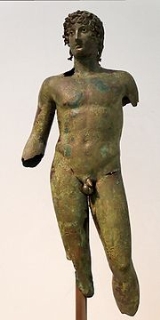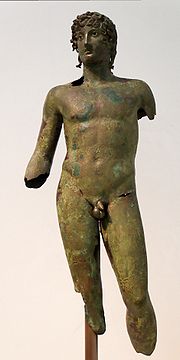
Athribis
Encyclopedia
- This article is about the ancient city called Athribis in Lower Egypt; for the ancient city called Athribis in Upper Egypt, see Athribis (Upper Egypt)Athribis (Upper Egypt)Athribis , also known to the ancient Greeks as Triphieion or Tripheion, and to the ancient Egyptians as Hut-Repyt, was an ancient city of Egypt, in the Panopolite nome. The modern village of Wannina in the Sohag Governorate is situated here...
Athribis or Athlibis (Greek
Greek language
Greek is an independent branch of the Indo-European family of languages. Native to the southern Balkans, it has the longest documented history of any Indo-European language, spanning 34 centuries of written records. Its writing system has been the Greek alphabet for the majority of its history;...
: or was the Greek name for two cities of ancient Egypt
Ancient Egypt
Ancient Egypt was an ancient civilization of Northeastern Africa, concentrated along the lower reaches of the Nile River in what is now the modern country of Egypt. Egyptian civilization coalesced around 3150 BC with the political unification of Upper and Lower Egypt under the first pharaoh...
: this article concerns the chief town of the Athribite, the Tenth nome
Nome (Egypt)
A nome was a subnational administrative division of ancient Egypt. Today's use of the Greek nome rather than the Egyptian term sepat came about during the Ptolemaic period. Fascinated with Egypt, Greeks created many historical records about the country...
, in Lower Egypt
Lower Egypt
Lower Egypt is the northern-most section of Egypt. It refers to the fertile Nile Delta region, which stretches from the area between El-Aiyat and Zawyet Dahshur, south of modern-day Cairo, and the Mediterranean Sea....
. The ancient city of Hut-Repyt in Upper Egypt
Upper Egypt
Upper Egypt is the strip of land, on both sides of the Nile valley, that extends from the cataract boundaries of modern-day Aswan north to the area between El-Ayait and Zawyet Dahshur . The northern section of Upper Egypt, between El-Ayait and Sohag is sometimes known as Middle Egypt...
, also called Athribis by the Greeks, is discussed at Athribis (Upper Egypt)
Athribis (Upper Egypt)
Athribis , also known to the ancient Greeks as Triphieion or Tripheion, and to the ancient Egyptians as Hut-Repyt, was an ancient city of Egypt, in the Panopolite nome. The modern village of Wannina in the Sohag Governorate is situated here...
.
Overview

Banha
Banha , also spelled Benha, is the capital of the Qalyubia Governorate in north-eastern Egypt. Egyptians call it Banha Elasal, which means "Sweet like honey"; the nomenclature originally comes from when the Prophet Muhammed sent his massage to Elmoqwqs to convert to Islam, he replied by sending him...
, north of Cairo
Cairo
Cairo , is the capital of Egypt and the largest city in the Arab world and Africa, and the 16th largest metropolitan area in the world. Nicknamed "The City of a Thousand Minarets" for its preponderance of Islamic architecture, Cairo has long been a centre of the region's political and cultural life...
, now marks its former site. Athribis stood upon the eastern bank of the Tanitic branch
Tanis, Egypt
Tanis , the Greek name of ancient Djanet , is a city in the north-eastern Nile delta of Egypt. It is located on the Tanitic branch of the Nile which has long since silted up.-History:...
of the Nile
Nile
The Nile is a major north-flowing river in North Africa, generally regarded as the longest river in the world. It is long. It runs through the ten countries of Sudan, South Sudan, Burundi, Rwanda, Democratic Republic of the Congo, Tanzania, Kenya, Ethiopia, Uganda and Egypt.The Nile has two major...
, now silted up, near the angle where that branch diverges from the main stream. Ammianus Marcellinus
Ammianus Marcellinus
Ammianus Marcellinus was a fourth-century Roman historian. He wrote the penultimate major historical account surviving from Antiquity...
reckons Athribis among the most considerable cities of the Nile Delta
Nile Delta
The Nile Delta is the delta formed in Northern Egypt where the Nile River spreads out and drains into the Mediterranean Sea. It is one of the world's largest river deltas—from Alexandria in the west to Port Said in the east, it covers some 240 km of Mediterranean coastline—and is a rich...
, in the fourth century AD. It seems to have been of sufficient importance to give the name Athribiticus Fluvius, the "Athribitic river", to the upper portion of the Tanitic arm of the Nile. Athribis was one of the military nomes assigned to the Calasirian militia under the Pharaoh
Pharaoh
Pharaoh is a title used in many modern discussions of the ancient Egyptian rulers of all periods. The title originates in the term "pr-aa" which means "great house" and describes the royal palace...
s. Under the Christian Emperors, Athribis belonged to the province of Augustamnica Secunda
Augustamnica
Augustamnica or Avgoustamnikai was a Roman province of Egypt created during the 5th century and was part of the Diocese of Oriens first and then of the Diocese of Egypt, until the Muslim conquest of Egypt in the 640s...
.
The Athribite name and its capital derived their name from the goddess Thriphis, whom inscriptions both at Athribis and Panopolis denominate the most great goddess. Thriphis is associated in worship with Amun Khem, one of the first quaternion of deities in Egyptian mythology
Egyptian mythology
Ancient Egyptian religion was a complex system of polytheistic beliefs and rituals which were an integral part of ancient Egyptian society. It centered on the Egyptians' interaction with a multitude of deities who were believed to be present in, and in control of, the forces and elements of nature...
, but no representation of her has been at present identified. John Gardner Wilkinson
John Gardner Wilkinson
Sir John Gardner Wilkinson was an English traveller, writer and pioneer Egyptologist of the 19th century. He is often referred to as "the Father of British Egyptology".-Childhood and education:...
supposes Athribis to have been one of the lion-headed goddesses, whose special names have not been ascertained.
The ruins of Atrib (Atrieb or Trieb), at the point where the modern canal of Moueys turns off from the Nile, represent the ancient Athribis. Until modern times, annual flooding of the Nile helped reduce the ruins to extensive mounds and basements, besides which are the remains of a temple, 200 feet (61 m) long, and 175 broad, dedicated to the goddess Thriphis (Coptic
Coptic language
Coptic or Coptic Egyptian is the current stage of the Egyptian language, a northern Afro-Asiatic language spoken in Egypt until at least the 17th century. Egyptian began to be written using the Greek alphabet in the 1st century...
: Athrébi). Most of the structures here can be associated with the 25th through 30th Dynasties. There is also an extensive Greek and Roman necropolis
Necropolis
A necropolis is a large cemetery or burial ground, usually including structural tombs. The word comes from the Greek νεκρόπολις - nekropolis, literally meaning "city of the dead"...
.
The monks of the White Monastery
White Monastery
The Coptic White Monastery is a Coptic Orthodox monastery named after Saint Shenouda the Archimandrite. It is located near the Upper Egyptian city of Sohag, and about four kilometers south east of the Red Monastery. The name of the monastery is derived from the color of the white limestone of its...
, about half a mile to the north of these ruins, are traditionally acquainted with the name for them of Attrib, although their usual designation of these ruins is Medeenet Ashaysh. An inscription on one of the fallen architraves of the temple bears the date of the ninth year of Tiberius
Tiberius
Tiberius , was Roman Emperor from 14 AD to 37 AD. Tiberius was by birth a Claudian, son of Tiberius Claudius Nero and Livia Drusilla. His mother divorced Nero and married Augustus in 39 BC, making him a step-son of Octavian...
, and contains also the name of his wife Julia, the daughter of Augustus
Augustus
Augustus ;23 September 63 BC – 19 August AD 14) is considered the first emperor of the Roman Empire, which he ruled alone from 27 BC until his death in 14 AD.The dates of his rule are contemporary dates; Augustus lived under two calendars, the Roman Republican until 45 BC, and the Julian...
. On the opposite face of the same block are found oval cartouches
Cartouche
In Egyptian hieroglyphs, a cartouche is an ellipse with a horizontal line at one end, indicating that the text enclosed is a royal name, coming into use during the beginning of the Fourth Dynasty under Pharaoh Sneferu, replacing the earlier serekh...
including the names of Tiberius Claudius
Tiberius Claudius Nero
-Roman Republic:* Tiberius Claudius Nero, the first man supposed to bear the name, son of Appius Claudius Caecus*Tiberius Claudius Nero * Three praetors whose lifetimes overlap:...
and Caesar Germanicus: and in another part of the temple is a cartouche of Ptolemy XII, the eldest son of Ptolemy Auletes (51-48 BC).
About half a mile from Athribis are the quarries from which the stone used in building the temple was brought; and below the quarries are some small grotto tombs, the lintels of whose doors are partially preserved. Upon one of these lintels is a Greek inscription, ideentifying it as the sepulchre of Hermeius, son of Archibius. He had not, however, been interred after the Egyptian fashion, since his tomb contained the deposit of calcined bones. Vestiges also are found in two broad paved causeways of the two main streets of Athribis, which crossed each other at right angles, and probably divided the town into four main quarters. The causeways and the ruins generally indicate that the town was greatly enlarged and beautified under the Ptolemies.

